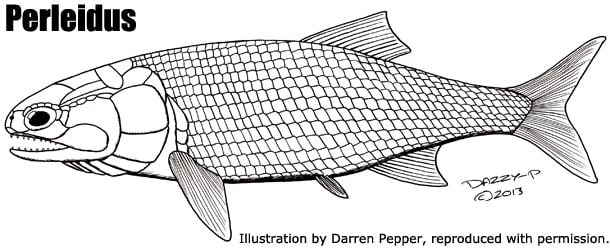In Depth
What had started in genera such as Canobius towards a better adapted open water predator form, Perleidus continued into the Triassic. Like earlier yet fairly recent for the time forms, Perleidus had a lower jaw that was suspended directly below the skull so that the mouth could be opened very wide, allowing for larger prey capture. Perleidus however had new developments of their own though. The fins of Perleidus had a reduced number of spines supporting them, and those still present were much more robust than previous older fish forms. This reduction and development meant that the fins of Perleidus were still robust enough to function, yet much more flexible. Combined with a tail that had roughly equal upper and lower lobes, Perleidus would have been among the fastest and most manoeuvrable fish swimming in the waters of the Triassic.
Further Reading
– Triassic Fishes from Spitzbergen, Part I - E. A. Stensi� - 1921. - Triassic Fishes from East Greenland collected by the Danish expeditions in 1929-1931 - E. Stensi� - 1932. - A New Species of Perleidus from Anhui. - D. Su - 1981. - Osteichthyes, in Triassic Fishes from the Cassange Depression (R. P. De Angola) - B. Schaeffer - 1990. - A new species of the genus Perleidus (Actinopterygii: Perleidiformes) from the Middle Triassic of Southern China. - C. Lombardo, Z. Y. Sun, A. Tintori, D. Y. Jiang & W. C. Hao - 2011.










